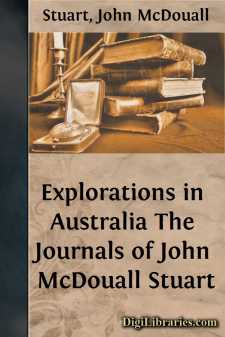Categories
- Antiques & Collectibles 13
- Architecture 36
- Art 48
- Bibles 22
- Biography & Autobiography 813
- Body, Mind & Spirit 142
- Business & Economics 28
- Children's Books 17
- Children's Fiction 14
- Computers 4
- Cooking 94
- Crafts & Hobbies 4
- Drama 346
- Education 46
- Family & Relationships 57
- Fiction 11829
- Games 19
- Gardening 17
- Health & Fitness 34
- History 1377
- House & Home 1
- Humor 147
- Juvenile Fiction 1873
- Juvenile Nonfiction 202
- Language Arts & Disciplines 88
- Law 16
- Literary Collections 686
- Literary Criticism 179
- Mathematics 13
- Medical 41
- Music 40
- Nature 179
- Non-Classifiable 1768
- Performing Arts 7
- Periodicals 1453
- Philosophy 64
- Photography 2
- Poetry 896
- Political Science 203
- Psychology 42
- Reference 154
- Religion 513
- Science 126
- Self-Help 84
- Social Science 81
- Sports & Recreation 34
- Study Aids 3
- Technology & Engineering 59
- Transportation 23
- Travel 463
- True Crime 29
Explorations in Australia The Journals of John McDouall Stuart
Description:
Excerpt
The explorations of Mr. John McDouall Stuart may truly be said, without disparaging his brother explorers, to be amongst the most important in the history of Australian discovery. In 1844 he gained his first experiences under the guidance of that distinguished explorer, Captain Sturt, whose expedition he accompanied in the capacity of draughtsman. Leaving Lake Torrens on the left, Captain Sturt and his party passed up the Murray and the Darling, until finding that the latter would carry him too far from the northern course, which was the one he had marked out for himself, he turned up a small tributary known to the natives as the Williorara. The water of this stream failing him, he pushed on over a barren tract, until he suddenly came upon a fruitful and well-watered spot, which he named the Rocky Glen. In this picturesque glen they were detained for six months, during which time no rain fell. The heat of the sun was so intense that every screw in their boxes was drawn, and all horn handles and combs split into fine laminae. The lead dropped from their pencils, their finger-nails became as brittle as glass, and their hair, and the wool on their sheep, ceased to grow. Scurvy attacked them all, and Mr. Poole, the second in command, died. In order to avoid the scorching rays of the sun, they had excavated an underground chamber, to which they retired during the heat of the day.
When the long-expected rain fell, they pushed on for fifty miles to another suitable halting-place, which was called Park Depot. From this depot Captain Sturt made two attempts to reach the Centre of the continent. He started, accompanied by four of his party, advancing over a country which resembled an ocean whose mighty billows, fifty or sixty feet high, had become suddenly hardened into long parallel ridges of solid sand. The abrupt termination of this was succeeded at two hundred miles by what is now so well known as Sturt's Stony Desert, to which frequent allusion is made by Mr. Stuart in his journals. After thirty miles more, this stony desert ceased with equal abruptness, and was followed by a vast plain of dried mud, which Captain Sturt describes as "a boundless ploughed field, on which floods had settled and subsided." After advancing two hundred miles beyond the Stony Desert, and to within one hundred and fifty miles of the Centre of the continent, they were compelled to return to Park Depot, where they arrived in a most exhausted condition.
A short rest at the Depot was followed by another expedition, Captain Sturt being on this occasion accompanied by Mr. Stuart and two men. The seventh day of their journey brought them to the banks of a fine creek, now so well known as Cooper Creek in connection with the fate of those unfortunate explorers, Burke and Wills. At two hundred miles from Cooper Creek Captain Sturt and his party were again met by the Stony Desert, but slightly varied in its aspect. Before abandoning his attempt to proceed, the leader of the expedition laid the matter before his companions, and he writes as follows: "I should be doing an injustice to Mr. Stuart and my men, if I did not here mention that I told them the position we were placed in, and the chance on which our safety would depend if we went on. They might well have been excused if they expressed an opinion contrary to such a course; but the only reply they made me was to assure me that they were ready and willing to follow me to the last."
With much reluctance, however, Captain Sturt determined to return to Cooper Creek without delay. They travelled night and day without interruption, and on the morning of their arrival at the creek, one of those terrible hot north winds, so much dreaded by the colonists, began to blow with unusual violence. Lucky was it for them that it had not overtaken them in the Desert, for they could scarcely have survived it. The heat was awful; a thermometer, graduated to 127 degrees, burst, though sheltered in the fork of a large tree, and their skin was blistered by a torrent of fine sand, which was driven along by the fury of the hurricane. They still had fearful difficulties to encounter, but after an absence of nineteen months they returned safely to Adelaide.
The discouraging account of the interior which was brought by Captain Sturt did not prevent other explorers from making further attempts; but the terrible fate of Kennedy and his party on York Peninsula, and the utter disappearance of Leichardt's expedition, both in the same year (1848), had a very decided influence in checking the progress of Australian exploration....


